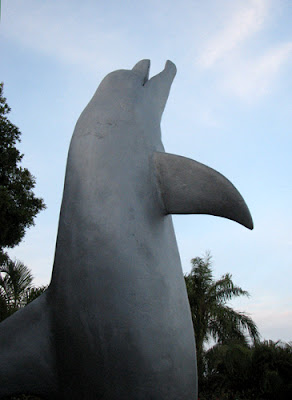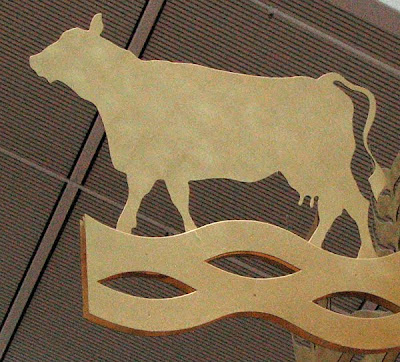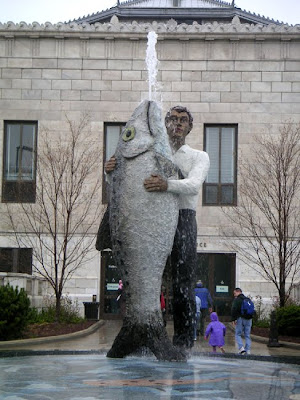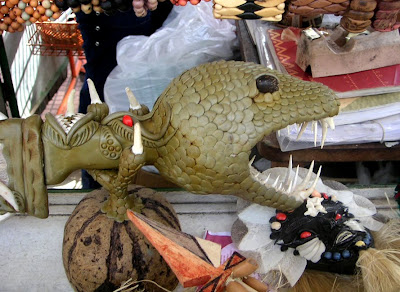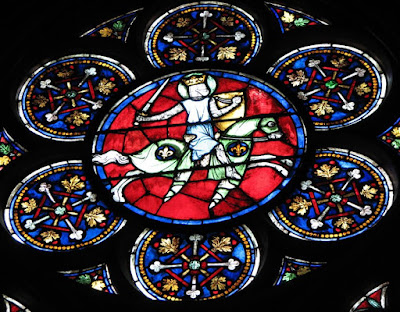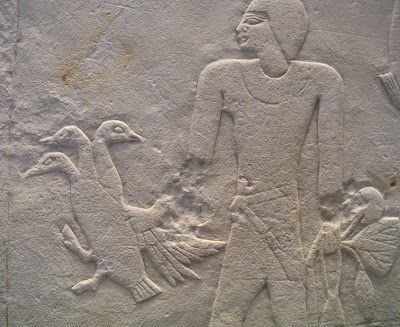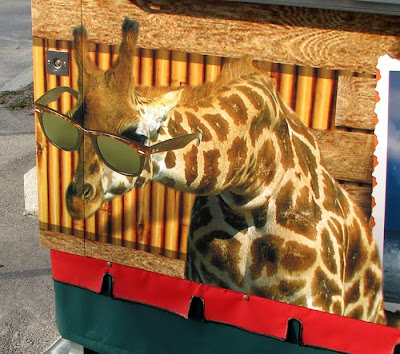Sunday, February 28, 2010
Pirie Scott Peacock
I love the animal art on this building in downtown Chicago. If the plaque I photographed a few minutes later is attached the same building as is adorned by the peacock and gryphons, the information is this:
Chicago Landmark
Carson Pirie Scott & Company Building
Louis H. Sullivan, architect
1899, 1903-1904
1906 addition by D.H. Burnham & Co.
The Carson Pirie Scott store ranks as one of the most important structures in early modern architecture. An example of 19th century modular construction, it also clearly expresses the period's philosophy about an ornamental architecture.
Designated a Chicago Landmark on November 5, 1970,
by the City of Council of Chicago,
Richard J. Daley, Mayor
Commission on Chicago Historical and Architectural Landmarks
Saturday, February 27, 2010
Pretty Mosaic on the Terminal Floor
Dallas/Fort Worth International Airport
This unexpected mosaic was quite large, and made a complete circle on the floor.
Friday, February 26, 2010
Thursday, February 25, 2010
Wednesday, February 24, 2010
Cow at Portland International Airport
Cow on a mobile sculpture near the ceiling
Tuesday, February 23, 2010
Palo de Sangre Jaguar from Colombia
"Palo de Sangre" is the type of red-colored wood used
I used to sell this type of wood carving in my Tapir and Friends online store; I imported them with the help of Sergio Sandoval of Bogota. I hope to do so again, but there are a few cost issues to overcome. The carvings themselves are not very expensive for their beauty and uniqueness, but (1) they are often damaged when being shipped through U.S. Customs. In each small shipment, a few are drilled, sometimes in the visible parts, to be sure there are no drugs inside, and they're "re-packed" in such a way that legs and tails are often broken when I get them. Another thing (2) is that each piece is unique, and I'm still looking for a cost-effective way to make them available to customers so that each piece can be seen and yet the prices aren't jacked sky-high because the process is labor-intensive. I love this native South American art, and hopefully will find a way to overcome the issues this year or next. I've heard that FedEx or UPS shipping may be safer through Customs than DHL, so I'll have to experiment.
You can read more about Palo de Sangre here, and you can see some of the carved pieces in this Picasa Web Album. I don't have a compliled album of all of the pieces that have come through here at this time, but I'll add it to my project list.
Monday, February 22, 2010
Sunday, February 21, 2010
Saturday, February 20, 2010
A Glyptodont You Can Ride In
I love the realism of these extinct and endangered animals on the Dodo Carousel. There was a plaque next to the carousel explaining what each animal was and giving the scientific name. After all, the Jardin des Plantes is one of the homes of the science of zoology as we know it. The glyptodont is an extinct relative of the armadillo.
Friday, February 19, 2010
Thursday, February 18, 2010
Alien Monster?
I couldn't tell you what this strange creature is other than some kind of imaginative or fantasy or mythological serpent. Note the teeth in the back of its neck. We saw this in the market square in Manaus, where I wanted to take home almost everything I saw, and fortunately (?) couldn't afford to and didn't have a big enough suitcase. Of course, it reminds me of the monster in Alien. Who knows? I don't even know what it's made of, other than it looks like modeling clay.
Wednesday, February 17, 2010
Estate Sale Birds
Here are a couple more things I wish I had kept. These birds make me smile.
Tuesday, February 16, 2010
Monday, February 15, 2010
Egyptian Ducks?
Labels:
2005,
bas relief,
birds,
carving,
chicago,
ducks,
egyptian,
illinois,
museums,
stone carving
Sunday, February 14, 2010
I Have No Idea
I sometimes hope that every animal image with a long nose is a tapir, but it's not. The teeth are clearly opossum-like. These two carved animal heads are masks. The ecru-colored fibrous fabric shrouds the wearer. The mask on the right is a crocodilian of some sort, and to the right of that are carved wood fish and a bird. The piranhas at the bottom are the real thing, just dried out.
Saturday, February 13, 2010
Taurus
October 15, 2008
I don't know the vintage of the flooring in front of the high altar (it looks relatively new), but it seemed strange to me that it was filled with signs of the Zodiac, as I had never associated these signs with Christianity. But I hadn't paid enough attention. It seems that the constellations helped people of the Middle Ages follow the dictates of the seasons in their preparation of food, planting of crops, and other seasonal activities that their lives depended on, or that added to their quality of life. These called Labors of the Months, and are often depicted around church doors, in stained glass, carved misericords, illuminated manuscripts, and elsewhere. Now I'll be looking for them!
Friday, February 12, 2010
Greeter at the Museum
October 14, 2008
Fortunately this stegosaurus near the front entrance to the Paleontology Museum moves slowly and seems to have a good disposition. I love it that the plantings in this area are some of the most ancient plants still existing.
Thursday, February 11, 2010
Wednesday, February 10, 2010
Tuesday, February 9, 2010
Monday, February 8, 2010
Ears
Museum at the John Day Fossil Beds National Monument
I'm not sure that this is properly "animal art," but what else are you going to call such creative genius applied to a working fossil lab?
Sunday, February 7, 2010
A Salmon at the Fish Ladder
The Lake Washington Ship Canal Fish Ladder
Saturday, February 6, 2010
Friday, February 5, 2010
Ceramic Sea Life
Women's Bathroom of the Oregon Coast Aquarium
Thursday, February 4, 2010
Peacock Bass with Lianas
We saw this hanging wood carving in the open-air market in Manaus. Note the spot on its tail; this is a peacock bass, a common fish in parts of Central and South America, and much prized for food. The man standing behind the carving is one of the team of IBAMA officials who were checking the market stalls for possible illegal items for sale. IBAMA stands for "Instituto Brasileiro do Meio Ambiente E Dos Recursos Naturais Renováveis" (Brazilian Institute of Environment and Renewable Natural Resources).
Wednesday, February 3, 2010
Tuesday, February 2, 2010
Suspended Squid
Pike's Market
Monday, February 1, 2010
Subscribe to:
Posts (Atom)


